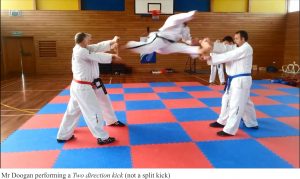Brendan Doogan 5th Dan, Dragon’s Spirit Papatoetoe
There are lots of things in Chang Hon Taekwon-Do [the style practised by ITF and similar groups]. There are kicks, punches, blocks and strikes, throws, crosscuts, sweeps, thrusts, locks and joint breaks, a million different ways of stepping, different kinds of sparring, patterns and board breaking, stretches and toughening exercises, terminology, theory and history.
However, there are things that aren’t in the art, things deliberately left out by General Choi, things that seem to have been overlooked, and things that people think are one thing but are in fact another.
Weapons are defended against in Taekwon-Do. In the full 15 volume Encyclopedia Of Taekwon-Do the Founder devotes 28 pages in Volume V to defending against a knife, bayonet, club or pole. However the use of weapons doesn’t play a part in Chang Hon Taekwon-Do, although other schools of the art do include their use, notably SGM Kim Bok Man’s school.
Most techniques and movements were given explicit applications, either in the literature or at IICs (International Instructors Course). For the most part Taekwon-Do is face value in that a technique is what it is, although clever repurposing can prepare for unexpected contingencies. Hidden techniques aren’t, therefore, a main part of the art – blocks are taught as blocks, locks as locks.
Some areas appear to have been overlooked. I suppose this was inevitable despite the General’s quest to design techniques for every situation. An example is the inward downward kick, which doesn’t appear in the Encyclopedia. Front pushing kick doesn’t either, and upper back elbow strike is a two-direction attack rather than being a high outward swing with the back of the elbow. Turning and reverse turning kicks aren’t shown in 360° versions in the books so far as I can tell. All these techniques are used by practitioners however, as they should be. The art was never meant to be static.
Finally there are things that are often misnamed. Axe kick, split kick, roundhouse and tornado kicks. None of these names exist in the literature. Nor do hook or uppercut, cross or jab, outside of descriptions of movements. Axe kick is properly named pick-shape kick / gokaeng-i chagi. Two direction kick / sangbang chagi can look like the splits, roundhouse is turning / dollyo, and tornado kick is most often applied to 360° kicks.

Our punches that resemble hooks are angle punch / giokja jirugi, turning punch / dollyo jirugi, and crescent punch / bandal jirugi. Uppercut for us is divided into upset punch / dwijibo jirugi, middle knuckle fist middle punch / joongji joomuk kaunde jirugi, and upward punch / ollyo jirigi. Jab and cross are words borrowed from boxing, where we make an obverse / baro and reverse / bandae distinction. The boxing convention of calling the rear handed punch a cross is much simpler.

Some of the misnomers and their correct names are tabulated below.
This technique… |
Is actually this technique… |
| Axe kick | gokaeng-i chagi / pick-shape kick |
| Split kick | sangbang chagi / two direction kick |
| Roundhouse kick | dollyo chagi / turning kick |
| Tornado kick | 360° kicks |
| Hook | giokja jirugi / angle punch
dollyo jirugi / turning punch bandal jirugi / crescent punch |
| Uppercut | dwijibo jirugi / upset punch
joongji joomuk kaunde jirugi / middle knuckle fist middle punch ollyo jirigi / upward punch |
| Jab & Cross | This is trickier. The front hand [“jab”] can be either baro jirugi / obverse punch or bandae jirugi / reverse punch depending on the handedness of the stance. A right punch on a right stance is obverse. A right punch on a left stance is reverse. Even weighted stances are left or right based on which foot is in front. Uneven stances are named right if the right leg is carrying more weight and vice versa. |
